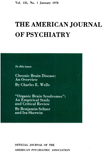THERAPY OF OBSESSIONAL STATES
Abstract
The goals and the treatment plan for the obsessional states have been outlined as follows:
1) To discover and elucidate the basis for the excessive feelings of insecurity which require absolute guarantees before action is pursued.
2) To demonstrate by repeated interpretation and encouragement to action that such guarantees are not necessary, but rather that they interfere with living. This requires active assistance in stimulating new adventures for the patient.
3) That the foregoing is possible only when the patient can acknowledge that anxiety is universal and omnipresent and cannot be permanently eliminated from life. This means abandoning the attempts at perfection and superman performance and accepting one's humanness with its limitations. It does not mean being mediocre, average or without ambition but rather it allows the individual to utilize all his assets and potentialities.
This is achieved through the trust and intimacy that grows out of a relationship in which one is sincerely trying to be useful to another human being. However, this also requires skill and intelligence, and the treatment must follow techniques that differ radically from the classical psychoanalytic model. We must avoid strengthening the patient's obsessional tendencies and tailor our technique to counter these devices and provide a learning experience which may enable him to alter his defensive patterns. An open, flexible technique with no rigid rules of procedure is demanded, as well as a therapist who is free to experiment and try any number of modifications in the therapeutic process.
Access content
To read the fulltext, please use one of the options below to sign in or purchase access.- Personal login
- Institutional Login
- Sign in via OpenAthens
- Register for access
-
Please login/register if you wish to pair your device and check access availability.
Not a subscriber?
PsychiatryOnline subscription options offer access to the DSM-5 library, books, journals, CME, and patient resources. This all-in-one virtual library provides psychiatrists and mental health professionals with key resources for diagnosis, treatment, research, and professional development.
Need more help? PsychiatryOnline Customer Service may be reached by emailing [email protected] or by calling 800-368-5777 (in the U.S.) or 703-907-7322 (outside the U.S.).



